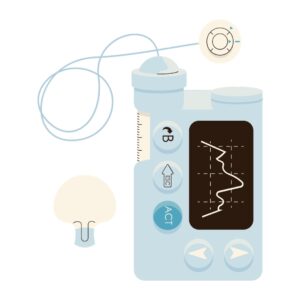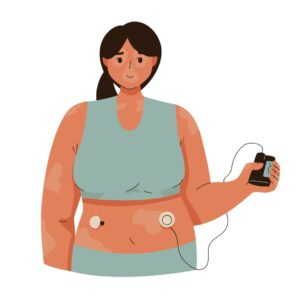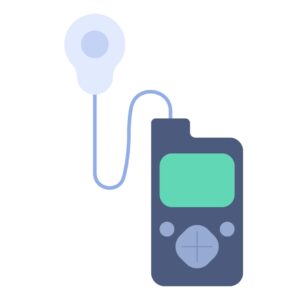Diabetes - Insulin Pumps
NHS Lanarkshire Insulin Pump and Technology Service
NHS Lanarkshire’s Insulin Pump & Technology Team provide support to people living with Type 1 Diabetes in Lanarkshire who are using some form of technology.
Meet our Diabetes Educator & Consultant Teams
| Diabetes Educators | Diabetes Consultants | |
| Covering all sites | Jacqueline Anderson Carol McNair |
|
| University Hospital Hairmyers | Eleanor McCabe Lorna Whitelaw Glen Youngman |
Dr Louise Clark |
| University Hospital Monklands | Lynn Doran Katrina Gallagher Lyn Wilson |
Dr Elizabeth McIntyre Dr Thekkepat Sandeep |
| University Hospital Wishaw | Hannah Innes Lesley Walker |
Dr Min Chong |
What is an Insulin Pump?
An insulin pump is a small electronic device that delivers insulin continuously 24 hours a day via a tiny tube called a cannula which sits underneath the skin. An insulin pump allows greater flexibility to match your insulin requirements to your lifestyle.
An insulin pump uses rapid acting insulin only, to deliver a steady basal rate of insulin across the day and night and can be programmed with different amounts of insulin at different times of the day.
When you eat, you deliver a bolus dose of insulin via the pumps bolus calculator to cover the carbohydrate content in each meal or snack.
Insulin pump therapy is also referred to as Continuous Subcutaneous Insulin Infusion therapy (CSII).
Types of Pumps
There are two types of insulin pump
- A tethered pump uses a fine tube to connect the pump to a cannula and the pump is usually worn in a belt or clipped onto clothing. All the controls are on the pump itself.
- A patch pump has no tubing and the pump is usually stuck onto the skin. It works by using a remote controller which needs to be with you at all times. A patch pump is disposable and will need changed every 3 days.

Hybrid Closed Loop System
Insulin pumps have become more advanced over the last few years and can now communicate with a Continued Glucose Monitor (CGM) or Sensor to provide a Hybrid Closed Loop (HCL).
An HCL system consists of wearing an insulin pump and a sensor that continuously measures glucose levels, and an algorithm that controls the delivery of the insulin.
This system is designed to automatically adjust basal insulin delivery depending on Sensor Glucose levels.
The pump calculates the amount of insulin you need to keep your glucose within a chosen target range.
Criteria for insulin pump therapy are as follows:
- You have Type 1 Diabetes and you are on multiple daily injections.
- You have attended a structured education programme for the management of your diabetes.
- You are struggling to keep your blood glucose / HbA1c levels within target using multiple daily injections.
- You are experiencing repeated and unpredictable hypoglycaemia episodes, causing anxiety and impacting on your quality of life.
- You are committed to and have the competency to use the equipment effectively.
- For women who are preparing for pregnancy who are unable to achieve appropriate blood glucose / HbA1c levels.
Advantages of insulin pump therapy are as follows:
- It can improve variability in blood glucose and HbA1c levels.
- It can improve Time in Range.
- It can reduce number of hypos.
- It can reduce the burden of Type 1 diabetes.
- It can deliver insulin in much smaller amounts than injections, which manages your control much more accurately.
- No need for multiple injections as you only need to change your cannula or patch pump every 2-3 days.
Disadvantages of insulin pump therapy are as follows:
- Blood glucose levels need to be monitored regularly and there can be an increased risk of Diabetic Ketoacidosis (DKA).
- Insulin pumps can fail or break, so you will need to ensure that you have an in-date and easily accessible supply of sub-cutaneous insulin supplies in case of problems.
- You will have to be permanently attached to the pump, which could have implications for the clothing that you wear and for your body image.
- You are more at risk of skin infections if you leave the infusion set in for more than 3 days.
What do you need to do?
- Your commitment to insulin pump therapy will require you to do regular blood glucose monitoring and attend for regular reviews with the dedicated Insulin Pump team based at your hospital site. This may be several times a year and consist of a range of health care professionals – Nurses, Dietitians and Consultants. These specialist staff can support you with training and ongoing self-management of this therapy.
- You will have to complete an education programme with regards to carbohydrate counting and insulin management, so that you can have a good understanding of how carbohydrates will influence your blood glucose levels.
- Insulin pump therapy is not an easy option but, if used appropriately, it can certainly provide a more flexible way of self-managing your day-to-day diabetes control.
Thinking about Insulin Pump Therapy?
| Thinking about Insulin Pump Therapy | Websites |
| General websites: | My Diabetes My Way eLearning (scot.nhs.uk) Insulin pumps Diabetes UK Guide to Diabetes Insulin pumps |
| ABCD/ DTN-UK websites: | Virtual Showroom ABCD (Diabetes Care) Ltd |
| Insulin Pump Therapy choices: | DTN – UK Education: Pumps (CSII) ABCD (Diabetes Care) Ltd |
| Starting up: Transferring from MDI to CSII: | DTN – UK Education: Pumps (CSII) ABCD (Diabetes Care) Ltd |
Pump and Technology Companies
| Pump and Technology Companies | Websites |
| Medtronic insulin pump & Carelink technology (Medtronic) |
MiniMed™ 780G system Medtronic Diabetes CareLink™ Personal Software – For people with Diabetes MiniMed™ Mobile App Quick Reference Guide Medtronic support & online services |
| Tandem t:slim insulin pump (Air Liquide) |
Online training modules by Making Diabetes Easier t:slim user guide |
| Omnipod 5 & Omnipod DASH insulin pump systems (Insulet) |
What is Omnipod – an introduction Omnipod DASH – user guide Omnipod 5 – user guide |
| Dana Diabecare-i insulin pump (Advanced Therapeutics) |
Advances Therapeutics (UK) Ltd Home page Dana Diabecare-i insulin pump user guide |

Line Cannula Selection
| Line Cannula Selection | Websites |
| Cannula Selection and Management: (General information) |
DTN-UK Education: Pumps (CSII) ABCD (Diabetes Care) Ltd |
| MiniMed™ Mio™ Advance infusion set: (Medtronic) |
The MiniMed™ Mio™ Advance infusion set Medtronic Diabetes |
| How to Insert an AutoSoft 90 Insulin Pump Infusion Set: (Tandem) |
|
| How to use the Omnipod DASH cannula: | Omnipod DASH® How to Insert the Pod’s Cannula YouTube video |
| How to use the Dana Inset II Infusion set: |
Established Insulin Pump Therapy Users
| Established Insulin Pump Therapy Users | Websites |
| Optimising Control – ABCD / DTN – UK websites | Please note, each website link takes you to a different page. |
| Accessing and Adjusting Basal Insulin Rates in Insulin Pump Therapy: | DTN – UK Education: Pumps (CSII) ABCD (Diabetes Care) Ltd |
| Using Bolus and Advanced Bolus Features: | DTN – UK Education: Pumps (CSII) ABCD (Diabetes Care) Ltd |
| Reading Downloads: | DTN – UK Education: Pumps (CSII) ABCD (Diabetes Care) Ltd |
| When Insulin Pump Therapy Doesn’t Work: | DTN – UK Education: Pumps (CSII) ABCD (Diabetes Care) Ltd |
| Insulin Pumps in Hospital / Sick Day Rules / Pump Failures: | DTN – UK Education: Pumps (CSII) ABCD (Diabetes Care) Ltd |
| Insulin Pumps and Exercise: | DTN – UK Education: Pumps (CSII) ABCD (Diabetes Care) Ltd |

Further Resources
Managing illness when using insulin pump therapy resources:

